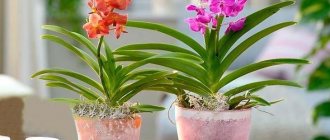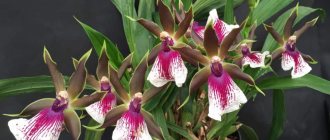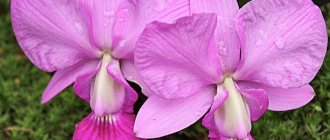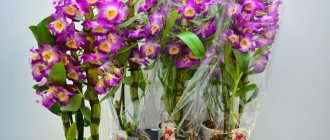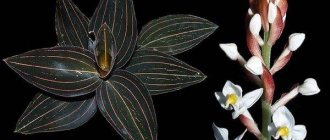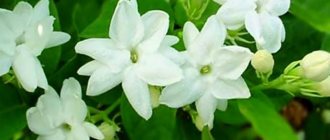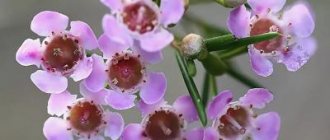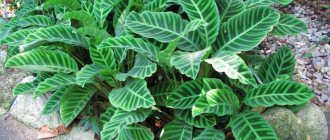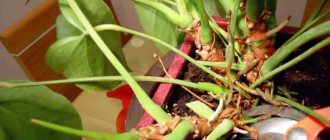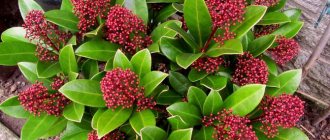In order for the odontoglossum to charm you with flowering, you will need create optimal conditions for it growths that will be most similar to natural ones.
To do this, the gardener must be theoretically savvy and know the strengths and weaknesses of a particular plant.
If this is not done, and if cultivation is neglected, then the orchid will not only not bloom, but may also die. You should be especially careful with capricious species . Let's find out in more detail what the Odontoglossum orchid looks like: its description, photo and care at home.
Short description
The odontoglossum orchid is becoming a very popular plant in indoor and greenhouse floriculture due to its ease of cultivation and long flower stalks, which often produce many impressive small flowers. In the photo you can see the Odontoglossum orchid.
Odontoglossum orchids are becoming more popular among amateur gardeners.
The plant genus is very polymorphic. The plant itself is medium to large in size, with closely spaced, flattened pseudobulbs. The leaves are leathery or soft, juicy. Flowers have:
- Various, unique colors;
- And a pleasant aroma.
They usually bloom once a year. Many odontoglossums have been linked by breeders through hybridization with other related orchids , such as Oncidiums. The goal of these processes is to produce more color variations and patterns, as well as strengthen the plant's resistance and immune system.
Varieties
"Margaret Holm"
It has flowers with a diameter of 5 cm with round petals narrowed at the base with wavy edges. The color of the flowers is burgundy. The petals have a white pattern.
"Purple Rain"
The diameter of the buds is 4 cm. The petals are purple with numerous light spots on the surface.
"Celle"
It is distinguished by the small size of its buds, reaching no more than 2 cm in diameter. The petals are rich yellow, with a brown leopard pattern on the surface.
"Geyser Gold"
A variety with large flowers with a diameter of 7 cm. The color of the petals is intense yellow. On their surface there are blurry brown patterns consisting of spots and strokes.
Most common colors
Flowers can come in a variety of shapes and shades. The most common plants found are :
- With whites;
- Red;
- Purple;
- Brown;
- And yellow flowers.
They can also be painted with a mixture of several colors and have a design or pattern.
Botanical characteristics
The genus contains about a hundred species of odontoglossums, not counting hybrid varieties. The name comes from the Greek odon (tooth) and glossa (tongue), referring to the two tooth-like projections at the base of the lip. As noted at the beginning of the article, this cold-growing orchid can be found in the mountainous regions of Central and South America.
Most plants are medium to large in size :
- Sympodial epiphytes;
- Lithophytes;
- Terrestrial plant species with short roots are rare.
Pseudobulbs are compact in size, slightly flattened with leafy bracts at the base . One bulb produces from one to three apical leaves.
Attention! Older pseudobulbs will lose their leaves over time but remain plump. They retain water and provide support for younger and growing pseudobulbs.
Leaves can be :
The Odontoglossum orchid can grow several flower stalks.
- Leathery;
- Or soft and juicy.
A peduncle grows from the base of the leaf , which can be straight or curved. There may be several peduncles and they may branch. Its length varies from species to species.
One plant can have a peduncle :
- Long - bear up to 150 flowers;
- Another has a short one with 20-30 flowers.
The flowers come in a wide variety of shapes and colors, up to 5-6 cm in diameter. The lip is quite complex, whole or with three lobes. Flowers found :
- Red;
- Yellow;
- Purple;
- As well as other colors and combinations.
Kinds
List of species according to the Royal Botanic Gardens at Kew as of 08/16/2009:
- Odontoglossum alberti P.Ortiz, 2005
- Odontoglossum alvarezii P.Ortiz, 2001
- Odontoglossum ariasii Dalström, 2001
- Odontoglossum armatum Rchb.f., 1876
- Odontoglossum aspidorhinum F.Lehm., 1895
- Odontoglossum astranthum Linden & Rchb.f., 1867
- Odontoglossum auriculatum Rolfe, 1892
- Odontoglossum blandum Rchb.f., 1870
- Odontoglossum callacallaense DEBenn. & Christenson, 2001
- Odontoglossum cirrhosum Lindl., 1833
- Odontoglossum constrictum Lindl., 1843
- Odontoglossum contaypacchaense DEBenn. & Christenson, 2001
- Odontoglossum crinitum Rchb.f., 1874
- Odontoglossum crispum Lindl., 1845
- Odontoglossum cristatellum Rchb.f., 1878 Odontoglossum cristatellum subsp. cristatellum
- Odontoglossum cristatellum subsp. lehmannii (Rchb.f.) Bockemühl, 1989
- Odontoglossum crocidipterum subsp. crocidipterum
- Odontoglossum portmannii subsp. cohrsiae Bockemühl, 1988
- Odontoglossum sceptrum var. facetum (Rchb.f.) Bockemühl, 1989
Odontoglossum spotted, or charming
Odontoglossum blandum
Odontoglossum blandum is a plant native to Ecuador and Peru. It is distinguished by spectacular white with purple or red-brown spots, pointed petals, tilted over the lip - large, with a yellow spot at the base and a massive creamy outgrowth.
Its three blades are like a crinoline skirt for young ladies, lush and openwork, the side blades are rounded, the central blade is sharp.
Odontoglossum crispum or curly
Odontoglossum crispum
Odontoglossum crispum, or curly one (Odontoglossum crispum) is considered the most beautiful orchid of the genus. Originates from the humid mountain forests of Colombia, found in the eastern Cordillera and the Andes at altitudes from 1800 to 3000 m. It grows as an epiphyte in clearings and forest edges in the partial shade of oak trees.
The pseudobulb is ovoid, with 2 or 3 soft-textured, belt-like leaves growing from its apex. The peduncle is formed at the base of the young pseudobulb and bears an inflorescence of 6–24 gracefully convex flowers with white or pale pink petals, elliptical and pointed at the apex.
Sometimes there is a slight reddish-brown spotting on the petals. The outgrowth at the base of the lip is yellow, often striped with dark red lines.
Odontoglossum lemon
Odontoglossum citrosmum
The inflorescences consist of lilac or light pink flowers, of which there are from 9 to 20 pieces. The lip is pale pink.
Odontoglossum heart-shaped
Odontoglossum cordatum
There are from 3 to 8 large flowers. The lip has a heart shape.
Odontoglossum large
Odontoglossum grande
Or “tiger orchid” is one of the most beautiful plants of the orchid family. For the most part, it is found in the mountain forest areas of central America, and more precisely, on the high plateaus of Guatemala and Costa Rica. As a rule, it prefers to grow at an absolute altitude of 2000–2500 meters.
Prefers sufficiently lit places that are well ventilated, for example: clearings, forest edges, banks of streams and rivers. In these places, both the air and the soil have a high moisture content throughout the year. This is facilitated by morning dew, which forms fog at night, as well as the evaporation of liquid from reservoirs.
Naturalist and plant collector Ure Skinner first described this species, finding it in a mountain gorge near the capital of Guatemala in the early 19th century.
This flower is rhizomatous, but the rhizome is securely hidden under pseudobulbs that have a flattened shape. As a rule, there are 2 or 3 such pseudobulbs. They are located very close to each other and are located above the rhizome. They have leaves that cover them from below.
1 or 2 peduncles grow from the leaf axil. Drooping inflorescences have a racemose shape and consist of large flowers (diameter from 12 to 15 centimeters), of which there are from 3 to 7 pieces (less often 9).
The color of the flowers is rich yellow and rather thick stripes of pale brown color are located transversely on their surface. The petals with wavy edges in the lower part have a pale brown tint and a yellow border, the upper part is rich yellow.
The small rounded lip has a yellowish-white or whitish color, and on its surface there are many reddish spots and streaks. Flowering can occur from the beginning of autumn to the middle of winter and lasts 4 weeks.
It feels normal when grown indoors, but such an orchid definitely needs a cool temperature regime.
Odontoglossum harryanum
Odontoglossum harryanum
The orchid is named after the famous English botanist and gardener Harry James Veitch.
It is found in the Department of Antioquia in Colombia and in the provinces of Morona-Santiago and Zamora-Chinchipe in Ecuador on the edges of fairly open cloud forests at altitudes from 1700 to 2500 meters.
The peduncle is slightly longer than the leaves, erect to slightly arched, 15–20 cm long, growing from the base of the youngest mature pseudobulb.
One peduncle bears 6–8 flowers with a diameter of up to 9 cm; on large healthy specimens there may be more flowers. The flowers are large, showy, and do not open fully.
The sepals are yellow-green with numerous nut-brown spots, which are absent only on the tips and on several transverse stripes.
Most of the petals are colored carmine red. The tip of the middle lobe of the lip is white, but turns yellow over time. At the base, the lip is decorated with many carmine-red stripes. The thickening near the base of the lip is lemon-yellow, the column is greenish at the bottom and yellow at the apex.
The upper sepal is elliptical, wide at the base, with a sharp tip and wavy edges, bends slightly forward over the column, but bends back at the apex. The petals are similar in shape and size to sepals.
It can bloom at different times, with peak flowering occurring from May to August.
Odontoglossum nice, or pretty
Odontoglossum gloriosum
Endemic to Colombia. Two-leaf pseudobulbs are densely located next to each other. From the axils of the lower leaves, 1 or 2 flexible peduncles with 6–10 snow-white flowers appear; in the center of each of them there is a yellow ridge rising above the shortened lip. It usually blooms from mid to late winter.
Features of flowering
Odontoglossum prefers to bloom every nine to ten months , from late winter to early summer, around February-March. In indoor conditions it can bloom in May-June. Flowering lasts about six weeks.
Stimulation
You can stimulate flowering by keeping the orchid dry (without watering for a month), while creating a significant temperature difference between day and night (5-6 °C).
Stimulating flowering using this method should be carried out only if the plant’s appearance indicates that it is ready to bloom: it is well-fed and healthy. Then you can give him a little push.
Attention! You should not stimulate flowering in odontoglossum if the grower lacks experience, or if the plant was transplanted, was sick, or was subjected to any other influences that could provoke stress. Depletion and weakening of the plant can lead to illness, and in the worst case, to the death of the specimen. Be careful.
Current question about the odontoglossum orchid
Question No. 1
What to look for when buying odontoglossum? First of all on the roots
An orchid for sale should not have soft and empty roots. You also need to lift the pot and rock it slightly. The bush should not dangle in the pot. Then you should inspect the leaves for stains, cracks, softening, plaque, and damage by pests. After this you need to look at the pseudobulbs. They should not be lethargic, wrinkled, or darkened. When pressed, the pseudobulbs should be elastic and dense.
First of all, on the roots. An orchid for sale should not have soft and empty roots. You also need to lift the pot and rock it slightly. The bush should not dangle in the pot. Then you should inspect the leaves for stains, cracks, softening, plaque, and damage by pests. After this you need to look at the pseudobulbs. They should not be lethargic, wrinkled, or darkened. When pressed, the pseudobulbs should be elastic and dense.
Question No. 2. Why do some orchid labels say “odontoglossum cambria”?
Because odontoglossum is very often crossed with orchids of other genera. Cambria are various intergeneric hybrids with genes of Miltonia, Brassia, Oncidium, etc. If an orchid says “Odontoglossum Cambria,” it means it is one of these hybrids.
Growing conditions and care
Lighting
Caring for an orchid at home requires painstaking and very careful work. Odontoglossum prefers moderate light , but this does not mean that it should grow in the shade all year round. It is best to place the plant where light can reach it but not burn it. The best location would be a meter from the western or eastern window.
On the south window, place the plant in the back of the room, and on the north window you can place it directly on the windowsill. At midday, especially on hot summer days, the plant should be covered (shaded) from the bright sun.
The Odontoglossum orchid should not be exposed to direct sunlight.
Artificial lighting will be the best friend of the odontoglossum, since, unlike the sun, you can control the intensity of the lamp yourself .
Greenhouses and similar structures (florariums) are also the best places to place these orchids, since sunlight can be filtered to some extent to a certain extent. Never place odontoglossum in direct sun - the leaves will get sunburned . The yellow-green color of the leaf is an ideal sign of optimal lighting.
Watering and humidity
Like most types of orchids, odontoglossums need to be watered once or twice a week depending on the weather. If the temperature is higher, more frequent and abundant watering is required, and vice versa when the temperature drops.
Advice! The only thing you should pay attention to is the growth of new pseudobulbs. When the young bulb begins to grow, increase watering and return to the weekly watering rule once it is fully formed.
The air humidity level should be from 50% to 70%, but not lower than 40%, otherwise the odontoglossum will dry out . To maintain an optimal level of humidity, orchids can be sprayed with settled or rainwater in the morning; try not to let droplets of moisture fall on the flowers.
Also place a tray with pebbles or expanded clay and water at the base of the orchid pot, but so that the bottom of the pot does not touch the water. The best solution would be to purchase an air humidifier or place the plant in a florarium.
Temperature
Odontoglossums are orchids that prefer cooler temperatures . The reason for this is that in the wild they grow:
- In the high Andes mountains;
- And the cool forests of Central and South America.
During the day, the ideal temperature would be between 15 and 27 °C. These plants can withstand warmer and colder temperatures, but not for very long. If they remain in these conditions, the flowers may not bloom or may even wither and fall off.
Always remember to provide adequate air circulation because they love fresh air, similar to plants in their natural habitat.
Feeding and fertilizer
Odontoglossums should be fed at least once a month. It is preferable to use special fertilizers for orchids in half the recommended dosage. Do not feed the plant!
Before fertilizing, it is necessary to moisten the root system of the plant. If this is not done, you may accidentally burn the roots or young shoots. Once a month, dry the container with the flower to remove any remaining salt deposits.
Important! During flowering, fertilizing is not carried out.
After flowering and during the dormant period
Odontoglossum is a tropical plant and does not have a dormant period as such. However, a conditional dormant period can be considered the time period from March to August, when the plant is actively vegetating and growing green mass. At this time, it is watered and fed abundantly.
Current question about the odontoglossum orchid
Question No. 1
What to look for when buying odontoglossum? First of all on the roots
An orchid for sale should not have soft and empty roots. You also need to lift the pot and rock it slightly. The bush should not dangle in the pot. Then you should inspect the leaves for stains, cracks, softening, plaque, and damage by pests. After this you need to look at the pseudobulbs. They should not be lethargic, wrinkled, or darkened. When pressed, the pseudobulbs should be elastic and dense.
First of all, on the roots. An orchid for sale should not have soft and empty roots. You also need to lift the pot and rock it slightly. The bush should not dangle in the pot. Then you should inspect the leaves for stains, cracks, softening, plaque, and damage by pests. After this you need to look at the pseudobulbs. They should not be lethargic, wrinkled, or darkened. When pressed, the pseudobulbs should be elastic and dense.
Question No. 2. Why do some orchid labels say “odontoglossum cambria”?
Because odontoglossum is very often crossed with orchids of other genera. Cambria are various intergeneric hybrids with genes of Miltonia, Brassia, Oncidium, etc. If an orchid says “Odontoglossum Cambria,” it means it is one of these hybrids.
Reviews
Oksana, Moscow: “ Spectacular in its beauty and very interesting orchid, which pleases with its flowers even in winter. It has been growing with me for several years now and, as it lives, it reproduces itself, so to speak. For some time I was worried that the old bulbs would die and my odontoglossum would die. But I soon became convinced that the bulbs grow faster than they die, and they can even be replanted as needed.
Amateur flower growers really like the Odontoglossum orchid for its extraordinary flowering.
I want to say that I came across a rather capricious specimen that requires attention to itself, but when it blooms, I understand that all my efforts are justified. The plant produces simply incredible flowers. Thanks, probably. That's how we live."
Boris, Rostov-on-Don: “ I have long wanted to diversify my orchid collection with something truly exquisite. I acquired a yellow odontoglossum with red spots. The coloring can be said to be aggressive, almost combative. Immediately attracts attention. The flowers, however, are small and do not last long, but they are not like others. The aroma can be a little annoying if the room is not ventilated, but overall it is pleasant and works well as an air freshener. Guests are immediately surprised when they enter the apartment, and everyone immediately wants to know what it smells like. Regarding care, I have been growing orchids for a long time and the flower has not caused any difficulties in caring for it. It is enough to provide him with the necessary conditions and maintain them.”
Snezhana, Kharkov: “ I had doubts about the purchase, because I was not confident in my abilities and capabilities to care for such beauty. However, my curiosity got the better of me and, to my surprise, it turned out that my odontoglossum, which I received in the mail, is no more picky than an ordinary store-bought phalaenopsis. Watching my handsome man, I realized that he loves fresh air and coolness, and prefers diffused light to bright light.
Sometimes I give my orchids a preventive measure - I bathe them in the shower, which they respond well to. This is especially noticeable on hot days, when the orchids really come to life after bathing.
Another thing I noticed, perhaps, is that the only difference between the odontoglossum and my phalics is that it is demanding of air humidity. Of course, it can adapt, but how great the plant looks, even without flowers, when you spray it regularly.”
Veronica, St. Petersburg: “ This is a wonderful gift, I was delighted when I first saw this beauty. It’s like the sun on a windowsill on a cloudy day - you look and your soul rejoices. Now I’m studying literature about my flower. I already understand that it will not be easy, but no one told me that it would be easy! I would like to buy a few more similar orchids. I am infinitely happy and grateful to my beloved.”
Selecting a location
An ideal place for odontoglossums may be a cold room or an unheated greenhouse. Odontoglossum hybrids grow better indoors because they are the result of crossing with heat-loving orchids.
If you place several plants nearby, they will develop better. From mid-May until the temperature at night reaches 10 degrees, it is better for this type of orchid to be outdoors (you can place them in the garden or on the balcony).
The place must be protected from wind, rain and direct exposure to the sun. This content allows plants to develop better and bloom more abundantly.
Find out the reasons why Dieffenbachia leaves turn yellow in our article.
Juniper will delight you with a variety of varieties that you can plant in your garden. More about this.
Calceolaria is a whimsical and easy-to-care flower. https://sad-doma.net/houseplants/dekarativnotsvetushhie/kaltseolyariya-uhod.html Note to the gardener.
Planting, transplanting and propagation
These orchids are mainly classified as epiphytes. So the best option for them would be to fix them on a block or plant them in the bark of coniferous plants.
Use smaller containers and a medium or fine substrate. Smaller pots are more practical , since the root system of the odontoglossum prefers close quarters.
Planting a plant will not cause any difficulties :
- Fill the pot 1/3 full with substrate;
- Place the plant in the pot;
- Gently distribute the roots;
- Fill the remaining voids with substrate.
Odontoglossums must be replanted at least once a year. Remove the old mixture and trim off any dead roots. At home, odontoglossum reproduces, like all sympodial orchids. You can verify the transplantation and division by checking whether the new shoot has grown 5-10 cm in height.
You can replant and plant if 3-5 young pseudobulbs have grown. After transplanting, water the plant sparingly until the roots begin to grow, then return to regular watering .
How to propagate a flower
Odontoglossum orchids are often propagated by division. Before this, the soil is dried, the rhizome is pulled out and the stem is cut with a disinfected knife blade. It is important that there are 2-3 bulbs left in each individual part. Damaged areas are treated with charcoal. The flower parts are placed in new containers. A layer of soil mixture suitable for orchids must be poured over the roots.
To prevent the plant from dying, keep it in a cool room and keep the soil moist. When new shoots and leaves form, the plant is grown like other adult orchids.
Main growing problems
Yellowish leaves mean the plant needs less light, while dark green leaves mean it needs more. The main problem is rotting of the root system due to flooding of the plant. This often leads to the death of the plant.
Another nuisance is the low level of humidity in apartments. Low air humidity can be detrimental not only to odontoglossum, but also to other tropical plants. This is especially dangerous in winter, when the heating is turned on and air humidity drops sharply to 30%.
Non-woody shade-tolerant plants
In temperate climates, many herbaceous plants and shrubs grow under a shady forest canopy that protects them from direct sunlight. Some of them (for example, hoofweed, goosefoot) manage to develop sufficiently during the spring in bright light, before the foliage of the tree layer blooms. That is, in the early period of development they are physiologically light-loving, and later they are shade-tolerant. As with tree species, shade tolerance among non-wood plants varies widely. Some early foliage plants persist after the tree canopy has closed, while others die quickly after completing their life cycle. An extreme example of this are winter annuals: they germinate in the fall, persist through the winter, and flower and fruit in the spring.
Although most plants grow towards the light (see phototropism), many shade-tolerant tropical vines (for example, Monstera attractive and many species of the genus Philodendron) initially, after germination, move away from the light. This helps them locate the tree trunk that serves as their support, and onto which they climb as they grow, reaching areas of brighter light.
Diseases and pests
Affected by pests such as:
- Spider mite;
- Mealybug;
- Shchitovka.
If a plant is damaged by insects, complex insecticides should be used in the dosage indicated on the package. To combat diseases, fungi and rot, use fungicides . If a plant is damaged by a viral infection, it is disposed of .
Prevention
The best prevention is to maintain the health of the plant and keep it in normal conditions . The healthier it is, the less likely it is to be affected by disease or insects.
Watering
The watering regime for such orchids depends on the temperature: higher temperature means watering more abundantly and more often. When watering, excess water should be freely removed from the pot; stagnation of water can lead to rotting of the lower parts of the plant and roots.
especially sensitive to watering. To water such orchids, it is appropriate to use a shower (temperature about 35 degrees). This creates conditions similar to natural ones and has a beneficial effect on the development and growth of the plant.
With regular use of such a hot shower, orchids develop green mass better and bloom more often. It should be noted that if the water is too hard, then this method is undesirable.
Instead, you should use filtered water or a mixture of tap water and distilled water (1:1 ratio). It is necessary to let the substrate dry thoroughly, but do not leave it dry for more than two days.
